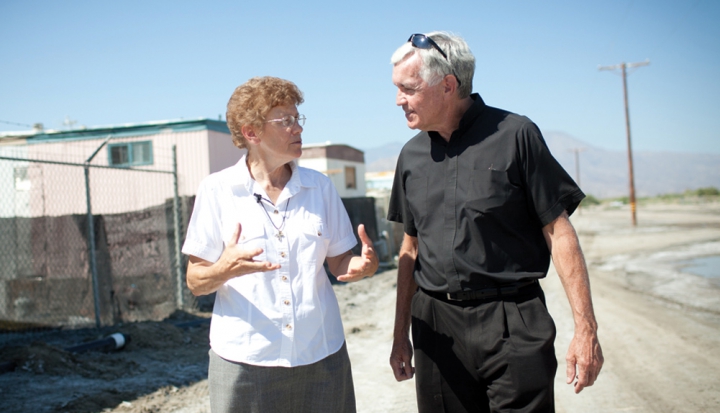An interview with Father Jack Wall, the president of Catholic Extension
Have you missed the excitement in Browning, Montana? Camden, Mississippi? French Camp, California? In each of these towns stands a Catholic community that is young, vibrant, afire with ideas and energy. Doubt it? Spend five minutes talking to Father Jack Wall, president of Catholic Extension.
Wall is the latest successor of Father Francis Clement Kelley, who at the dawn of the 20th century met Catholics who had neither priest nor church. Kelley began sending priests out in train cars and motor chapels to say Mass, forming the Catholic Extension Society to support the outreach. Since 1910 Catholic Extension has been under the pope’s guidance.
Like Kelley, Wall proclaims the great things happening in the far corners of our country. He enlists others to join him in the work of building churches, supporting seminarians, and sustaining ministries in “mission dioceses” that lack the resources to support themselves. “We’re not in this thing for ourselves,” he says. “We’re in this thing for mission—to do God’s work in the world. I’ve been given the gift of walking into places I never would have gone to.
“You would think some of these might be the most godforsaken and dispirited places,” says Wall. “But within these faithful communities you sense the good news of what life is, and it shines. They are some of the most joyful places I’ve ever been.”
What does the term “mission diocese” mean?
We are all familiar with “mission countries”—the Society for the Propagation of the Faith reaches out to those. The United States was a mission country until 1905. One of the reasons that Catholic Extension came into existence that same year was because of the imbalance of resources in Catholic communities in the United States. Often when we think about U.S. Catholicism, we think about the big urban dioceses with all the Catholic institutions: grammar schools, high schools, colleges, universities, hospitals, social service centers, and charities.
A mission diocese is a place in which the Catholic Church is present but without a lot of resources. Often, due to a lack of financial resources, the church is unable to provide basic necessities, such as the ability to pay the salaries of all its clergy or religious. So it needs financial support.
The church in these areas also often needs personnel. It doesn’t have the strong ministers or ministries that you would normally associate with a diocese.
And often there is the reality of a large geographic space. Alaska, for example, has three dioceses. The Diocese of Fairbanks is one and a half times the size of Texas. The Anchorage archdiocese is the size of Montana, and the Juneau diocese is the size of Florida. In these places distance matters. Alaskans may have to travel 60 to 100 miles to attend church, or may live in a place accessible only by airplane.
In some parts of the country, the south for example, Catholics are the minority in a community whose cultural life is largely Baptist, Evangelical, or Pentecostal. In the Diocese of Brownsville, Texas, a densely Catholic place, 50 percent of the population lives below the poverty line.
Mission dioceses like these are under-resourced in a number of different ways and need help. Mission dioceses comprise two thirds of the land mass in the United States, and 13 of the 65 million Catholics in the United States in at least 30 states. We also include the territories—anywhere the American flag flies.
In your travels, do you see clear differences between the church in mission dioceses and areas where church institutions are strong?
One of the great discoveries I’ve made as president of Catholic Extension is how Catholic communities in mission dioceses have a sense of responsibility for the church. Catholics in mission dioceses ask: “How are we the Catholic Church in this community, and how do we express ourselves as a Catholic community?”
God lives every day in these communities because the people there are the church. They own that sense of responsibility: “We are the Catholic community in this locale. We have to create its expression in terms of its ministries.”
Many of these communities have no priest. They are lay communities of Catholics who create the church in their particular place. So church is not so much a place that they go to—instead they say, “We are the Catholic Church in this community. How do we express ourselves?” So they express their faith in how they become a community of faith formation, of transformation, and of compassion. There’s a sense of, “We’re here to do God’s work.” They have a sense of mission beyond themselves, extending to the poor communities around them.
In many of these communities, up to 80 percent of Catholics tend to be people who have joined the church because of what they witness among the Catholics around them. A great example is a wonderful community of African American Catholics, Sacred Heart in Camden, Mississippi. They absolutely believe that their purpose is to transform the world. It’s a very small community, and they’re extremely ecumenical.
They host a praise night with the Protestant churches. The Protestant churches come to the Catholic church and have an evening of praise and prayer, and the choirs and people come together.
There’s a very ecumenical dimension to it. Their outreach to the poor and the hungry is extraordinary as well. There’s a tremendous sense of the church’s mission. It’s a very small community, but they are reaching literally thousands of people.
This sounds different from city or suburban parishes, where pastors may have to encourage people to take responsibility for their parish.
It is a very freeing vision of church. The best way I’ve heard it said is, “The church doesn’t have a mission. The church is mission.” People really understand that the church is not a member-centered reality; it’s a mission-driven reality.
You become a Christian, and you understand that to be a Christian, to be baptized, is to take responsibility for doing God’s work. That is the lived experience of these communities. They know that there will not be church unless they are church together. It is not “my” faith as an individual, but it’s this faith-filled community. It’s less individualistic, and it’s about personal responsibility.
What does the parish structure look like when there is no priest?
It’s always laypeople doing the work. The priest comes to the communities but isn’t necessarily part of day-to-day life. You see a lot of deacons and their wives, as couples, taking leadership roles. The presence of women religious is unbelievable.
Two of the most inspirational things I’ve learned are: First, you cannot go to the poorest places in the United States and not find the Catholic Church. The church’s presence is very strong and very transformative in these communities.
And second, the face of ministry in the poorest communities of America is commonly a woman religious. Frequently, it tends to be women religious who are in a certain season of their life. They have often served in big dioceses, as presidents of universities or hospitals, principals of schools, and other leadership roles.
Many say, “I’ve done that, and I’m not going to go back to the motherhouse, but rather I’m going to die with my boots on.” They’re choosing to serve until they can’t serve anymore. It’s a profound witness of women religious in our country.
The lay Catholic community has to take responsibility for its church life. Often when there cannot be a priest there are community services celebrated in those places. You see the simplest of church buildings, and they’re some of the most beautiful places I’ve ever visited. They tend to be spotlessly clean and beautifully decorated with fresh flowers, so when you walk in you think, “Here are people who really care for their community and are creating a sacred place.”
These places are sacred to them. They can be very simple structures, but it is their place of gathering and worship, and the place where they feel the presence of the risen Christ in their faith community.
Catholic Extension has built 12,000 churches in the United States. There are whole states of the union in which practically every Catholic church has been built with assistance from Catholic Extension.
Often in places where there is real violence, especially among the border towns near Mexico where there’s a lot of drug trafficking, the church is a place of refuge. It is a safe haven.
Why is a church building so important in these communities?
In contrast to what’s going on in some of the larger metropolitan dioceses, instead of closing churches, we’re opening them, and the ones we have are expanding.
There’s huge growth in the Catholic population in the dioceses that we are serving. It is not a church retrenching itself, it’s a church expanding and growing significantly. A lot of that growth is in the emerging Latino communities. It’s one of the great issues that face American Catholics and the United States—how the growing Latino population can become for us a moment of new energy and a new blessing to the churches.
America is built around immigration, and this is the new immigrant experience. They bring a tremendous sense of faith, family, and work ethic. It’s been an absolute joy to experience these communities. As for the churches, the buildings we’re talking about are simple buildings. They’re not extravagant. We’re not building mini-cathedrals. These churches tend to be very simple places, based on the idea that, “If you build it, they will come.”
One of the original ideas of Catholic Extension from Day 1 was that the church gave people a place to gather. I think that that’s been our experience. You give people a place to gather and let them take over from there.
Who are the Catholics living in these communities?
They tend to be vibrant and youthful. Their concern for their young people, as well as the role the church plays for young people, is huge.
Bishop Daniel Flores down in Brownsville, Texas says, “Preteens have got to make a choice between life and death.” The church is the one place that tells them, “You don’t have to join a gang. You don’t have to get involved in the drug culture.”
For people who are in challenging socioeconomic positions, their faith shows them that they are more than their circumstances. The fact that they can rise above their situation is absolutely central to their life. They’re not people who want to be dependent; they are looking to take responsibility for their lives and their families.
USA Today had a piece about what goes into moving people into a situation in which poverty doesn’t control their lives. The number one thing is a sense of meaning and purpose. To transform yourself you’ve got to have this piece of the puzzle, and that’s what Catholic Extension is about.
It’s about creating communities in which faith makes us aware that, “If God is up to something in me, and my life is more than my circumstances, I can take responsibility to change my life and the circumstances in which I live.” It is a key ingredient, I think, to address the issue of poverty.
Can you give an example?
José and Digna Lopez are a Hispanic couple who have been very involved in Stockton, California. The city is bankrupt, the community is heavily challenged right now, and the drought in the whole agricultural portion of California is horrific. It’s a very challenging place. Many of the people are first- and second-generation farm workers.
This couple has probably touched the lives of literally 150,000 people. They have been very present, particularly to youth and young adults. The Hispanic population is young, and this couple has a huge impact on the lives of the people.
One of the things I was most struck by is that they never ask people just to belong. They always ask people to take responsibility for their baptismal call.
If the church is going to be this transformative community in our world, you’ve got to step up, and you’ve got to bring your gifts and your talents. Once again, it’s about the church’s mission.
One of the things that José and Digna have given witness to is what an ecumenical marriage looks like. In a very subtle but beautiful way, their reverence toward each other and the dignity that they show to each other as husband and wife is just profound. I see young couples walking in that model, and I’m just blown away by the beauty of these young marriages and their family life. As Pope Francis is saying, we’re not proselytizing, we’re giving witness to a way of being and a way of living that is absolutely transformative.
In the Blackfeet American Indian community in Browning, Montana, the priest has served for more than 20 years. A Catholic sister has walked alongside him through that same time. The priest has brought the Cursillo movement into this community, and now about 150 couples have walked through Cursillo.
Because of that adult faith movement, they’ve transformed the community in which they live. So in a culture that is plagued by drugs, by alcoholism, by joblessness, by domestic violence, all of a sudden you’ve got 300 people saying, “We’re going to have good marriages and good family life.”
One of the transformative things they did was to start a Catholic school. In the Bureau of Indian Affairs schools, the kids have to face drugs and suicides and often it is just hellish. So this community appealed to the Christian Brothers’ San Miguel Schools to open a school, and they were turned down seven times.
Finally on the eighth visit, the Christian Brothers said, “OK, you win.” They started a middle school, Little Flower. So the kids go to Little Flower and then on to the BIA high school. Over the last three years, two of the valedictorians at the high school are kids from the San Miguel School. One of them got a scholarship to Gonzaga, and another a four-year, pre-med scholarship to Stanford. It all started with a faith community.
Another important thing about mission dioceses is that they produce many vocations to the priesthood, religious life, and lay ministry.
Why do you think that’s the case?
I keep asking myself that question. Demographically, the Latino experience looks like the European immigrant experience. In addition, young people are involved in their church, and the church itself calls people toward leadership. Young people see that responsibility can be exercised through ordination, religious life, or lay ministry. It’s that constant call of people to leadership.
Right now we are helping to support more than 600 vocations in these dioceses, and the numbers in some dioceses would shock you. The diocese of Little Rock, Arkansas has 125,000 Catholics on the books. They think there’s double that if you include the Hispanic communities that for all kinds of reasons may not be fully registered. They have more than 50 seminarians.
I would not be surprised in the years ahead if places like Little Rock, Arkansas send priests to Chicago or to one of the other large dioceses. Actually, there’s one priest from the Diocese of Little Rock who is going to Ireland because he believes that he’s more needed there with so few vocations in that country.
We also started an initiative to bring women religious to these communities from Latin America. Women religious really touch in profound ways the lives of Latino Catholics. In 10 dioceses, we are bringing 30 women religious into a new partnership. Women religious from communities in Latin America will give five years of service in the United States, working primarily with immigrants.
In return, we offer bilingual and bicultural education opportunities and other enhancements for their own capacity as sisters. At the end of five years, they’ll go back to Latin America, with greater training and insight. And hopefully then a new group of sisters will come to the United States to replace them.
We also have a program in which we send young adults from mission dioceses to Boston College, Notre Dame, and Fordham to get two-year degrees in pastoral theology and ministry. The young adults commit to going back to their dioceses for two years to serve among youth and young adults. Catholic Extension funds 60 percent of the whole thing. Our goal is to keep bright, young Catholics in their own dioceses.
Why do you think young people in mission dioceses tend to see the church differently than someone from an urban community?
We’ve created such strong institutions in large metropolitan dioceses, and we can take great pride in them. I really believe institutions such as Catholic universities, hospitals, and schools make a difference.
The underside of it is that the movement side of church is often lost. You need youth movements. You’ve got to give young people a sense that they are the church. It’s not, “Wait for 10 years until you get to be an adult.” I think that “you are the church” feeling is strong in the mission dioceses.
We’ve got to break out and see church as mission and not as member-centered. We’re not a club. In clubs you get, “You’re in or you’re out.” We don’t want anyone to feel out. All are welcome.
One of the great American church historians—David O’Brien, a retired professor from Holy Cross—always said the Catholic Church is the healthiest when it has a really strong sense of church as institution and church as movement. The two of them are meant to feed each other. They are meant to make both happen. If you go to Europe, the church is primarily about movement. They don’t talk much about parish life; it’s all about what movements you belong to. We have lost the sense of that movement approach in the United States.
You’ve said that many of the dioceses you work with have high rates of poverty. How does that factor into your work?
In Pope Francis’ The Joy of the Gospel, the pope tells the whole church to go to the margins. I don’t think he’s saying we should just take care of people, but rather understand this mystery of solidarity. The church is a sacred communion of people that breaks through all the distinctive elements of our lives that so often create division: male and female, rich and poor, young and old, healthy and sick.
All those terms are not our deepest truth. I think what he’s inviting us to do is to experience the gift of one another. When you do that, you’re letting God’s work be expressed in all of its profundity. We are really meant to be blessed to each other. The great call of God to Abraham and Sarah was, “I will make you a blessing to all the nations.”
I think we have to let people who express their faith at the margins of society also care for us. I think we’ve all experienced that. You reach out and say, “Gee, I thought I was going to be helping somebody, and I feel so much more blessed by them.” Catholic Extension is a vehicle for making this happen. It’s a conduit to bring the American Catholic community together.
So what about the big question in society right now: What do we do with the poor? I’d like to suggest to American Catholics that one of the most profound things you can do about poverty in the United States is help build up Catholic faith communities in poor places, and watch what happens. If you’re a person in poverty, you’ve got to have a sense of your own dignity, your own sacredness, your own worth, a sense that God is up to something in your life. Then all kinds of other things can happen.
It’s about personal transformation. When you get the sense that, “My life is sacred. My life is worthwhile,” then anything can happen. It sounds like a very subtle thing. I say this to a lot of people in the philanthropic community: If you want to fight poverty, invest in some of these Catholic communities.
Would many Catholics think of that as a way to fight poverty?
When you stop and think about it, there is no Catholic Charities without a Catholic faith community. There are no Catholic schools. There are no Catholic hospitals. There are no Catholic social services. There’s no Catholic relief. All of these things are expressions of the life of the Catholic faith community.
What I would love to see is a focus on building up the Catholic faith community. When other immigrant groups came to the United States to start a community, they only brought their faith. Then they built a parish, and the parish built the school, and it went on from there. But it starts with a Catholic faith community, so our strategy, our energy, our focus should be on building up Catholic faith communities.
This is part of our Catholic identity: We support the places in our country that can’t support themselves. Giving to Catholic Charities, which is a wonderful organization, is charity. But giving to your parish, your diocese, to the global church—and giving to something like Catholic Extension—is an expression of what being Catholic is and of what the church does.
This interview originally appeared in the July 2015 issue of U.S. Catholic (Vol. 80, No. 7, pages 18–22).
Image: Courtesy of Catholic Extension













Add comment